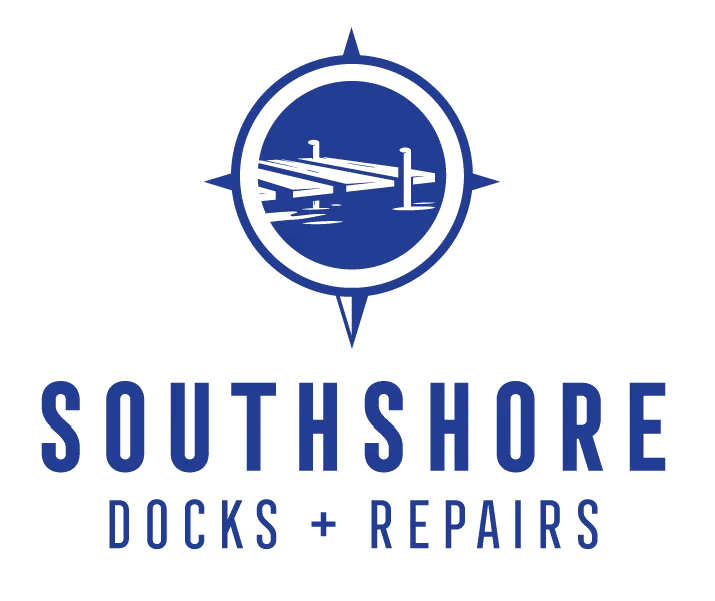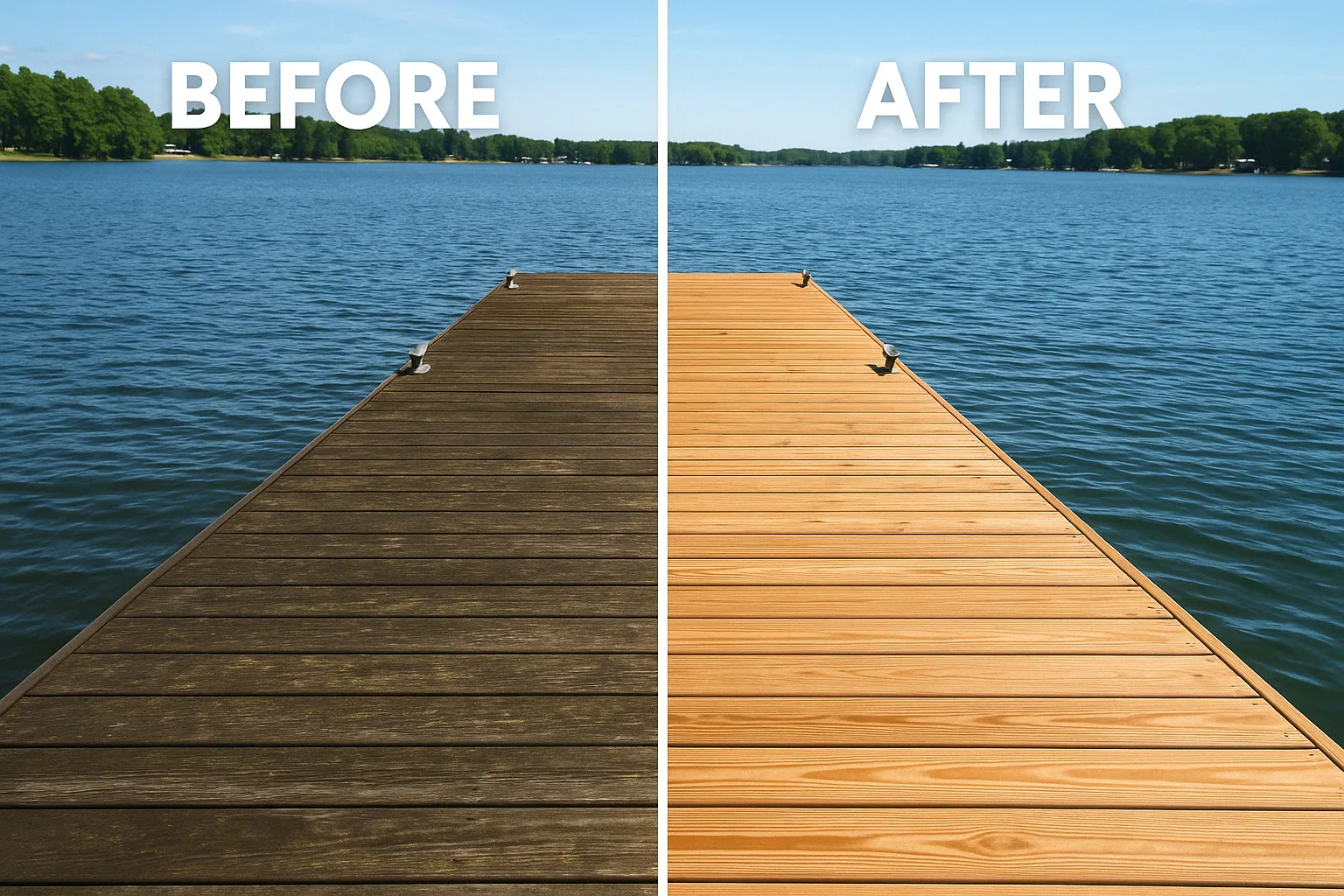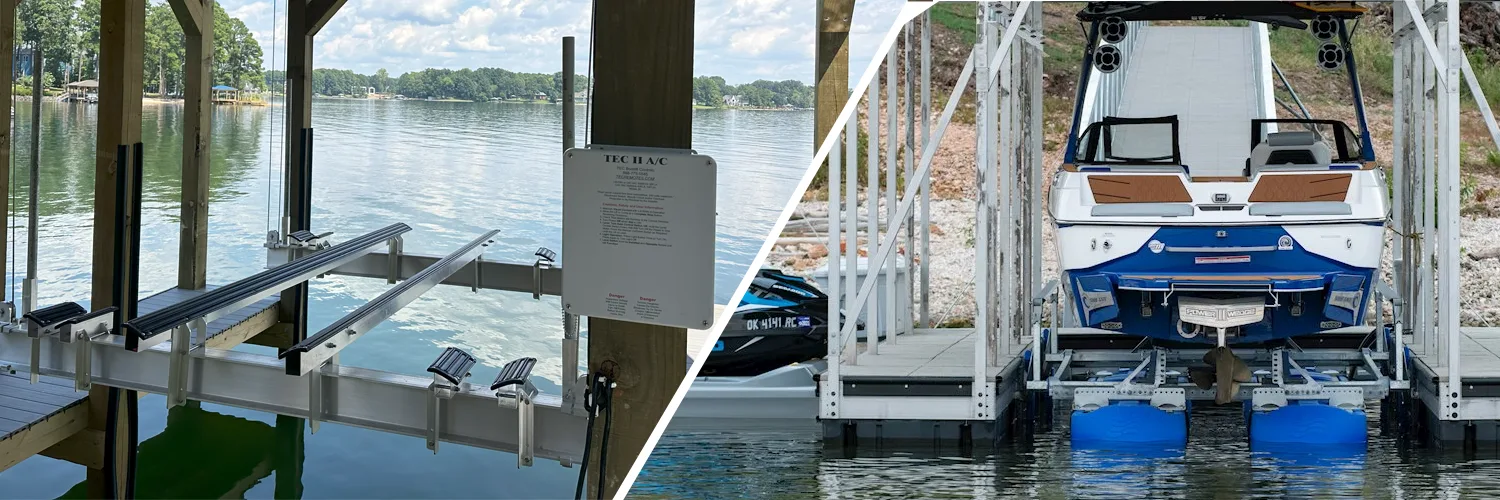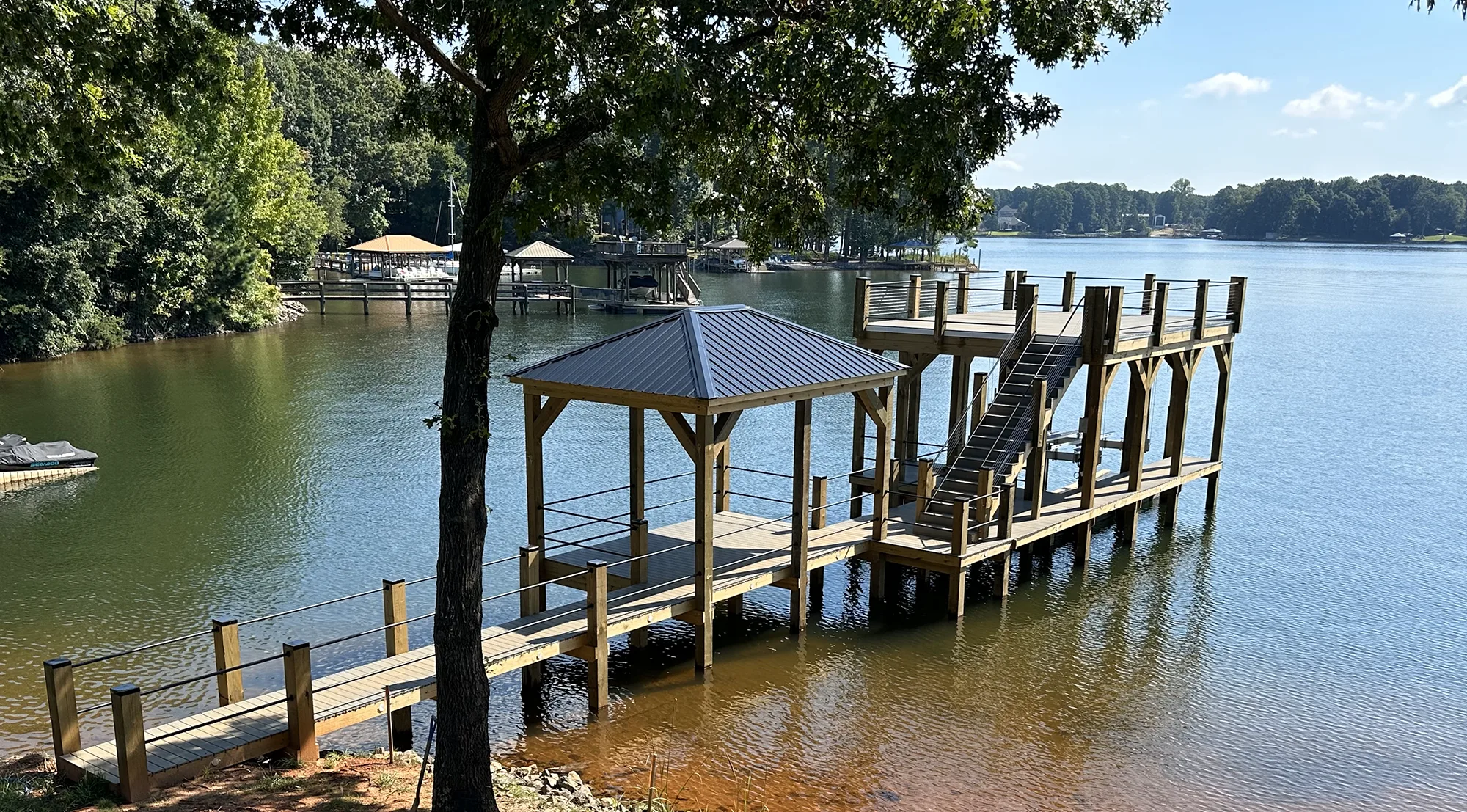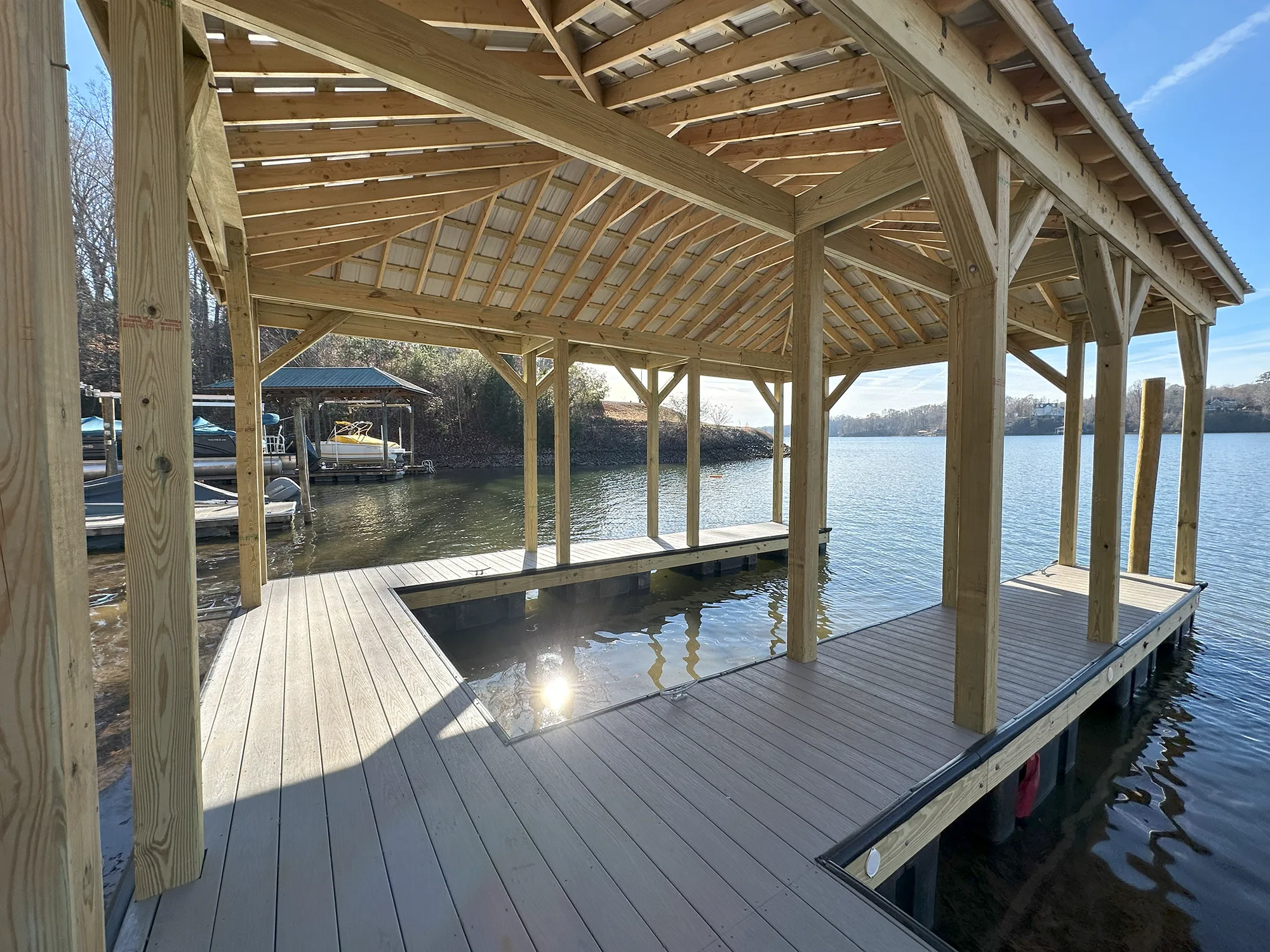Lake Norman is a prime location for boating, fishing, and relaxing by the water. But before you launch your boat or host a lakeside gathering, it’s crucial to ensure your dock is in top condition. A damaged or unstable dock can pose serious safety risks and lead to costly repairs if issues go unaddressed.
Whether you own a floating or fixed dock, harsh weather, constant water exposure, and everyday wear and tear take their toll. Knowing the 5 signs your dock needs repairs before boating season on Lake Norman can help you address problems early, keeping your waterfront safe and functional.
Let’s dive into the key warning signs that your dock may need professional attention before the season kicks off.
1. Warped or Rotting Wood
Wooden docks are particularly susceptible to warping, splitting, and rotting due to their constant exposure to water and sunlight. If you notice boards that feel soft underfoot, have visible cracks, or appear discolored, it’s time to take action.
Why This Matters:
- Rotten wood weakens structural integrity – what starts as a small issue can quickly lead to unsafe conditions.
- Warped boards create tripping hazards – uneven surfaces increase the risk of slips and falls.
- Moisture damage spreads fast – ignoring one bad plank can lead to widespread deterioration.
What You Should Do:
- Conduct a thorough inspection of all wooden components, including decking, posts, and railings.
- Check for soft spots, splintering, or mold growth that indicate water damage.
- Replace compromised boards and consider sealing or staining your dock for added protection.
Don’t let rotten wood put your dock out of commission. If you notice signs of deterioration, contact SouthShore Docks and Repairs for professional dock maintenance before the season begins.
2. Loose or Unstable Dock Pilings
Dock pilings serve as the foundation of your structure, keeping it anchored and stable. Over time, these pilings can become loose due to shifting water levels, erosion, or impact from boats and debris.
Warning Signs:
- Pilings wobble or shift when pressure is applied.
- Visible cracks or splitting at the base of the pilings.
- Uneven dock surface, indicating structural instability.
Why This Needs Immediate Attention:
- Loose pilings compromise the dock’s overall stability, making it unsafe.
- Severe movement can cause sections of your dock to collapse into the water.
- Weak pilings increase the risk of dock failure during storms or heavy boat traffic.
How to Address the Issue:
- If your pilings move under pressure, schedule a professional inspection.
- Consider reinforcing existing pilings or replacing them with longer-lasting materials like composite or treated wood.
- Inspect underwater pilings for erosion or marine life damage that could weaken the structure.
A strong foundation is the key to a safe dock. If your pilings show signs of weakness, don’t wait—schedule repairs with SouthShore Docks and Repairs today.
3. Rusted or Corroded Metal Components
Docks often feature metal fasteners, bolts, cleats, and brackets that hold the structure together. Over time, exposure to moisture and fluctuating temperatures leads to rust and corrosion, which can cause parts to weaken or break.
Common Metal Issues:
- Rusty bolts and screws – weakening connections between dock components.
- Corroded brackets and hinges – leading to loose or failing attachments.
- Pitting or flaking metal surfaces – a sign that materials are deteriorating.
Why This is Dangerous:
- Corroded metal can break without warning, leading to potential injuries or dock failure.
- Rust weakens structural integrity, making railings, ladders, and supports unsafe.
- If left unchecked, corroded components can compromise the entire dock.
What to Do About It:
- Inspect all metal components at least once a year.
- Replace rusted fasteners with stainless steel or galvanized alternatives for longer durability.
- Consider adding a protective coating to prevent further corrosion.
A little rust might not seem like a big deal, but it can lead to major dock failures. If you notice corrosion, contact SouthShore Docks and Repairs to replace compromised components before the boating season begins.
4. Loose or Failing Connections Between Dock Sections
Many docks, especially floating ones, are made up of multiple connected sections. Over time, the fasteners, joints, or hinges that hold these sections together can loosen, making your dock unstable.
Signs Your Dock Sections Are Loose:
- Gaps forming between dock sections.
- Sections move excessively when walked on.
- You hear creaking, squeaking, or grinding noises when using the dock.
Why This Needs Immediate Attention:
- Loose sections create an uneven walking surface, increasing the risk of accidents.
- Strong waves or heavy boat traffic can cause sections to detach completely.
- If connections fail, you may need major repairs instead of minor fixes.
How to Fix This Issue:
- Check all brackets, hinges, and fasteners connecting dock sections.
- Tighten or replace any damaged hardware to reinforce the structure.
- If the issue persists, consider upgrading to a more secure dock connection system.
A stable dock is a safe dock. If your dock sections feel loose or wobbly, let SouthShore Docks and Repairs inspect and reinforce them before the season starts.
5. Unstable or Failing Dock Floats
Floating docks rely on buoyant floats to keep them above water. If one or more floats are compromised, your dock may become unbalanced or sit lower in the water than normal.
Signs of Float Failure:
- One side of the dock sits lower than the other.
- You notice water inside the floats, indicating a leak.
- The dock becomes unstable or tilts when weight is applied.
Why You Need to Act Fast:
- A sinking dock is a major safety hazard.
- Waterlogged floats lose buoyancy, making the dock unusable.
- Float failure can cause uneven weight distribution, leading to stress on the structure.
How to Address the Issue:
- Inspect all dock floats for cracks, leaks, or damage.
- Replace damaged or waterlogged floats to restore balance.
- Upgrade to higher-quality, UV-resistant floats for longer durability.
If your floating dock is tilting, sinking, or unstable, call SouthShore Docks and Repairs to fix the problem before it becomes dangerous.
Final Thoughts: Get Your Dock Ready for Boating Season
Ignoring dock damage can lead to costly repairs and serious safety risks. By addressing these 5 signs your dock needs repairs before boating season on Lake Norman, you can ensure your waterfront is safe, functional, and ready for a summer of fun.
Need a dock inspection or repairs? Contact SouthShore Docks and Repairs today for expert service on Lake Norman, Lake Wylie, and Mountain Island Lake!
Table of Contents
Continue Exploring!
Owning a dock on Lake Norman is a dream come true — but regular care is key to protecting that investment. Whether you're in Cornelius, Huntersville, Denver, or one of the beautiful towns surrounding Lake Norman, dock maintenance on Lake [...]
Owning a boat on Lake Norman means year-round adventure. But protecting your investment is just as important as enjoying the ride. That’s where a boat lift comes in.Boat lifts help prevent hull damage, reduce maintenance, and keep your vessel in [...]
The Importance of Choosing the Right Dock for Your Property A well-designed dock is the centerpiece of any waterfront property. Whether you use your dock for boating, fishing, swimming, or simply enjoying the lake view, choosing the right type is [...]
Owning waterfront property on Lake Norman is a dream come true. Whether you use your dock for boating, fishing, entertaining, or relaxing by the water, a well-designed dock can enhance your experience and increase your property value. Choosing the right [...]
